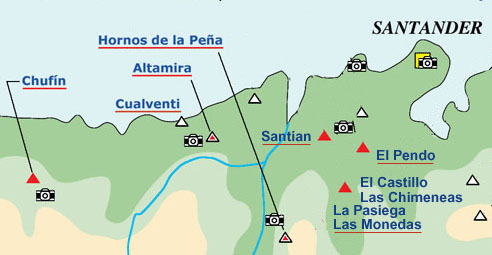Photo Archives: Paleolithic Art in Northern Spain
El Castillo III
Preview Edition
- 42 photos(about1280x1000,1470x980/JPEG) .
- Commentary by César González Sainz & Roberto Cacho Toca, Univ. of Cantabria.
- Royality Free for private and educational use.
In this downloadable photo archives are contained 42 photos of Paleolithic cave art of El Castillo cave with the archeological data and commentary as shown in this preview pages. Only the small sized reference images and a part of commentary are shown in this preview edition, but if you are interested to see more and to use these photos, please go to Kagi store and purchase the data package. Once payment has been made at the Kagi store, you will receive an e-mail containing the URL to download the data package. All photos that are contained in this package are ROYALITY FREE for private and educational use.
 El Castillo Cave
El Castillo Cave
This cave takes its name from the hill where it is situated, overlooking the town of Puente Viesgo, in the center of Cantabria. In 1903, an important archaeological deposit was located in the entrance vestibule of the cave, and numerous paintings and engravings were discovered in its interior. Hermilio Alcalde del Rio, a local teacher, was the discoverer, and he also undertook the first studies in the site. Later, at different times during the century, other caves were found in the same hill, whose entrances had been blocked and hidden by collapses. These are the caves, each with an archaeological deposit and cave art, of La Pasiega, Las Chimeneas and Las Monedas; as well as La Flecha, which only had an archaeological deposit in its entrance.
In the Upper Paleolithic, the large outer rock-shelter at El Castillo, 190m above sea level and facing east-northeast, was occupied much more often than the other caves which were then open. It was thus the main habitat in the hill and in all the immediate geographical area. These other smaller caves, despite being in the same intensely karstified limestone hill, seem to be mere satellites of the great habitat and decorative complex centered on El Castillo. They were occupied more occasionally as camps, for meetings and diverse activities, some of which would have involved the production of cave art.
-----------------------------------------
[References]
Alcalde del Rio, H. 1906. Las pinturas y grabados de las cavernas prehistóricas de la provincia de Santander: Altamira, Covalanas, Hornos de la Peña, Castillo. Impr. de Blanchard y Arce, Santander.
Alcalde del Rio, H.; Breuil, H.; Sierra, L. 1911. Les cavernes de la région Cantabrique. Imprimerie Vve. A. Chéne. Monaco.
Cabrera Valdés, V. 1984. El yacimiento de la cueva de "El Castillo" (Puente Viesgo, Santander). Bibliotheca Praehistorica Hispana, XXII. Madrid.
Leroi-Gourhan, A. 1965. Prehistoire de l'art occidental. Mazenod, Paris.
Moure, A.; González Sainz, C.; Bernaldo de Quirós, F.; Cabrera Valdés, V. 1996. "Dataciones absolutas de pigmentos en cuevas cantábricas: Altamira, El Castillo, Chimeneas y Las Monedas". A. Moure (ed.), "El Hombre fósil" 80 años después. pp 295-324, Universidad de Cantabria, Santander.
|
Photographed by Takeo Fukazawa & Co-Project Team of Texnai Inc. and the University of Cantabria
Commentary by César González Sainz & Roberto Cacho Toca, Univ. of Cantabria
Texnai Inc.:
2-1, Udagawa-cho, Shibuya-ku, Tokyo, Japan. Tel:03-3464-6927 Fax:03-3476-2372
e-mail:info@texnai.co.jp
Copyright reserved by Takeo Fukazawa &Texnai, Inc., University of Cantabria, IPA
|
|